Horseshoe Crab Facts Give Us a Lot to Learn About
Horseshoe Crabs And Relationships Are Worth Working On
Studying horseshoe crab facts has taught me that relationships take work. Even our relationship with nature. If we are to develop a biophilic relationship with the natural world, we must work at it. As parents, my wife and I are mindful of developing a positive relationship between our twin boys and nature. A personal relationship with the natural world will help them become better stewards of our environment.
This concerted effort is realized in a variety of ways. But each Spring, we have one event that has become a tradition in our family –viewing the horseshoe crab migration along the coast of Delaware Bay. The annual outing is as much a social event with friends as it a natural history tour (relationships take work!).
But the point is that we get out, spend time together and hopefully learn a little. And, horseshoe crab facts give us a lot to learn about — from migration and tides to predatory relationships and surgical prep, to how our behavior impacts these prehistoric critters.
More by Chris Pupke: Wood Ducks: A Cautionary Tale with a Happy Ending?
Horseshoe Crab Facts and Background:
The Atlantic horseshoe crab (Limulus polyphemus) is an ancient animal that is more than 300 million years old. They shed their exoskeleton more than one dozen times before it sexually matures. Males are smaller than females. The tail (known as a telson) helps flip the horseshoe crab over if it is stuck on its back – it is not used to sting. They have a total of nine eyes –and each eye consists of about 1,000 receptors. The diet consists mostly of clams and worms. They can live up to 20 years or more.
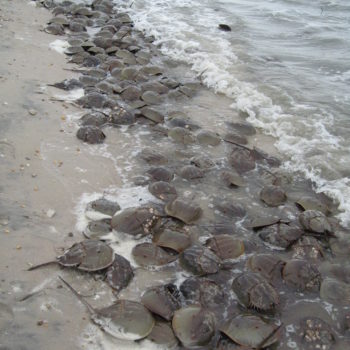
Horseshoe crabs emerge from Delaware Bay to breed on Spring tides in late May and early June. Photo courtesy of Chris Pupke.
Horseshoe crabs are more closely related to spiders than crabs but they are predominantly an aquatic animal. Spending most of the year in the Atlantic Ocean, they return each Spring to sandy beaches to breed.
The Decline of Horseshoe Crabs
Horseshoe crab numbers have been in decline in recent years. This decline stems from a variety of factors including over-harvesting for bait and loss of habitat due to shoreline development and climate change. Today, horseshoe crabs are considered vulnerable (the classification before endangered) by the International Union for Conservation of Nature (IUCN) due to over-harvesting. Fortunately, harvesting limitations implemented in recent years have helped reverse the decline. However, the IUCN notes that habitat loss is an on-going threat to healthy populations of horseshoe crabs.
Horseshoe Crab Migration:
The horseshoe crab migration to the Delaware Bay beaches is a remarkable phenomenon. At high tides during late May and early June (especially the spring tides associated with the full and new moons), hundreds of thousands of horseshoe crabs storm the beaches to reproduce.
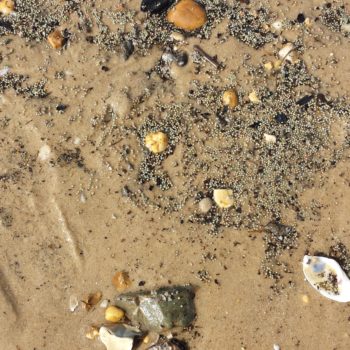
One female horseshoe crab can lay tens of thousands of eggs. Photo courtesy of Chris Pupke.
Female horseshoe crabs can lay tens of thousands of eggs – and this is where the lesson on predatory relationships comes in. In an impressive piece of evolutionary timing, countless migratory shorebirds arrive on the Delaware coast at the same time as the horseshoe crabs.
Red Knots Rely On Horseshoe Crabs:
The Rufa Red Knot (Calidris canutus rufa), for example, travels thousands of miles from their overwintering grounds in the Tierra Del Fuego in southern South America and need fuel to continue their journey to their northern breeding grounds in the Canadian Artic –a journey of almost 10,000 miles.
Unfortunately, with the population decline of horseshoe crabs, Red Knot populations have experienced significant declines. Some estimate the population has dropped from 100,000 to 13,000 along the Delaware Bay. This decline is exasperated by climate change which is disrupting the critical timing Red Knots need to have to gorge on the horseshoe crab eggs. The Rufa Red Knot is now listed as a threatened species under the Endangered Species Act. The Red Knot’s critical reliance on horseshoe crabs is a potent reminder of the interconnectedness of our environment.
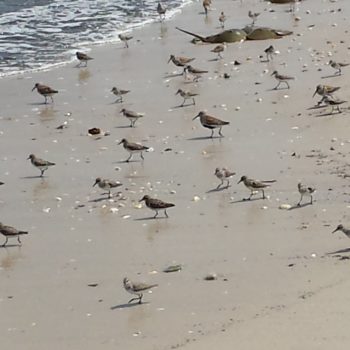
Shorebirds, including Rufa Red Knots, time their migration to arrive at Delaware Bay to gorge on horseshoe crab eggs. Photo courtesy of Chris Pupke.
Similarly, juvenile Atlantic loggerhead sea turtles rely on horseshoe crabs as a food source and the horseshoe crab population decline has negatively impacted loggerhead populations.
Horseshoe Crabs And Medicine?
But it is not just Red Knots that we are harming through our actions that imperil horseshoe crabs. We are also harming ourselves in a direct way.
In 1956, Fred Bang, a Johns Hopkins trained scientist, noticed that, when exposed to even the tiniest amount of gram-negative bacteria, horseshoe crab blood coagulates. This observation led to the development of a test to determine if bacteria are present. The test (Limulus amoebocyte lysate) is used on all surgical implants and each drug that the FDA approves to ensure that these items are bacteria-free –helping to prevent serious bacterial infections from gaining a footing.
Horseshoe crabs are not killed to get their blood. After harvest, the horseshoe crab is bled of a portion of its blood. It is then returned to the ocean. The mortality of horseshoe crabs in this process is believed to be low but new research is suggesting that it may be greater than initially believed. In response, a synthetic alternative is being developed to help preserve the horseshoe crab population.
Conversation and Conservation:
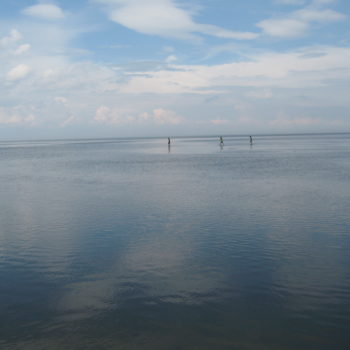
The twins and their friend explore Delaware Bay in search of horseshoe crabs migrating toward the shore to bred. Photo courtesy of Chris Pupke.
By late in the day, we have waxed poetic about migration, Red Knots, bloodletting, loggerheads and more, and we know it is time to return to focus on our relationships with the boys. Our last stop on our horseshoe crab tour is at Bowers Beach, DE where, after scanning the beach for more horseshoe crabs and shorebirds, we retire to JP’s Restaurant to talk about the day. The conversation will range from triple backflips on the trampoline, to the bane that is the designated hitter rule in baseball and back to horseshoe crabs and how we are all here together.
That we are all here together is a lesson that needs special attention, particularly during these times – whether we talk about the interconnectedness of horseshoe crabs and Red Knots or our relationships with one another or the impact our actions have on those people and critters we have never met. It is a central tenet to Biophilia Foundation that we acknowledge these relationships, honor them, and work to improve them.
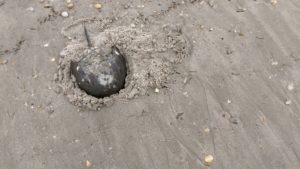
A female horseshoe crab laying eggs on a sandy beach along Delaware Bay. Photo courtesy of Chris Pupke.
Sources:
https://abcbirds.org/bird/red-knot/
https://www.aqua.org/Experience/Species-Spotlights/horseshoe-crab
http://dnr.maryland.gov/fisheries/Pages/horseshoe-crab.aspx
https://www.fws.gov/northeast/redknot/
http://www.iucnredlist.org/details/11987/0
https://www.nwf.org/Educational-Resources/Wildlife-Guide/Invertebrates/Horseshoe-Crab
https://projects.ncsu.edu/project/bio402_315/Lecture%20two/limulus.html
https://www.scientificamerican.com/article/medical-labs-may-be-killing-horseshoe-crabs/
https://www.theatlantic.com/technology/archive/2014/02/the-blood-harvest/284078/ (This article includes an interesting photo of horseshoe crab blood collecting.)

Recent Comments